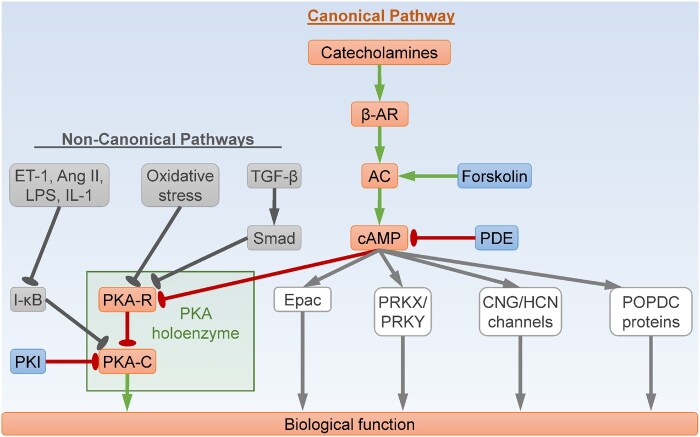Figure 1.
PKA signalling pathway. The canonical cAMP-dependent PKA pathway is initiated by catecholamines, which stimulate β-adrenergic receptor (β-AR) to induce adenylyl cyclase (AC)-mediated cAMP synthesis. The second messenger cAMP then binds the PKA regulatory (PKA-R) subunits, leading to release of the PKA catalytic (PKA-C) subunits and subsequent kinase activation. The non-canonical pathways of PKA activation are cAMP-independent. For example, oxidative stress or TGF-β induces PKA activation through blocking PKA-R-mediated sequestration of PKA-C, whereas ET-1, Ang II, LPS, or IL-1 derepresses I-κB-mediated inhibition of PKA-C. On the other hand, cAMP also exerts its biological functions through direct binding with other effectors beyond PKA, including Epac, PRKX, PRKY, CNG ion channels, HCN ion channels, and POPDC proteins. Ang II, angiotensin II; cAMP, 3',5'-cyclic adenosine monophosphate; CNG, cyclic nucleotide-gated; Epac, exchange protein directly activated by cAMP; ET-1, endothelin-1; HCN, hyperpolarization-activated cyclic nucleotide-gated; I-κB, inhibitor of κB; IL-1, interleukin-1; LPS, lipopolysaccharides; PKA, cAMP-dependent protein kinase, or protein kinase A; PDE, cyclic nucleotide phosphodiesterase; PKI, a PKA inhibitor; POPDC, popeye domain containing; PRKX/Y, protein kinase X/Y-linked; TGF-β, transforming growth factor-β. Arrows indicate activation; bar-headed lines indicate inhibition.

